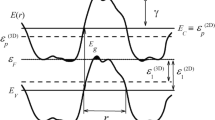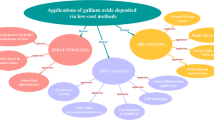Abstract
NbGe2 thin films and hot pressed powder samples were made over a wide range of preparation conditions. Resistive and inductiveT c values, residual resistance ratios, specific resistances, and grain sizes were determined as a function of the substrate temperature during evaporation. C40-NbGe2 thin films have a maximum resistiveT c of 2.18 K and an inductiveT c of 2.10 K. The maximum residual resistance ratio was 17.7, the lowest specific resistance at room temperature was 57 µΩ-cm. During formation at higher temperatures or under pressure NbGe2 has an affinity for carbon and nitrogen, leading to the formation of niobium carbonitrides with aT c up to 16.2 K. PublishedT c values up to 16 K for NbGe2 are probably due to a contamination with niobium carbonitride.
Similar content being viewed by others
References
A. K. Ghosh and D. H. Douglass,Phys. Rev. Lett. 37, 32 (1976); A. K. Ghosh and D. H. Douglass, inSuperconductivity in d- and f-Band Metals, Second Rochester Conference, D. H. Douglass, ed. (1976), p. 59.
C. M. Knoedler and D. H. Douglass,J. Low Temp. Phys. 37, 189 (1979).
J. J. Hanak, J. I. Gittleman, J. P. Pellicane, and S. Bozowski,J. Appl. Phys. 41, 4958 (1970).
G. F. Hardy and J. K. Hulm,Phys. Rev. 93, 1004 (1954).
J. P. Remeika, A. S. Cooper, Z. Fisk, and D. C. Johnston,J. Less Common Met. 62, 211 (1978).
M. Kloska, Diploma thesis, University of Karlsruhe (1982).
O. Meyer, H. Mann, and E. Phrilingos, inApplication of Ion Beams to Metals, S. T. Picrauxet al., eds. (Plenum Press, New York, 1974), p. 15; D. Dew-Hughes and R. Jones,Appl. Phys. Lett. 36, 856 (1980).
S. A. Wolf, Naval Research Laboratories, Washington, D.C., private communication.
M. Kloska and E. L. Haase, submitted toJ. Less Common Met.
P. Scherrer,Göttinger Nachrichten Math. Phys. 98 (1918).
W. Stocker, Zulassungsarbeit, University of Karlsruhe (1980).
J. Geerk and K. G. Langguth,Solid State Commun. 23, 83 (1977).
J. L. Jorda, R. Flükiger, and J. Müller,J. Less Common Met. 62, 25 (1978).
U. Schneider and J. Geerk, KfK-Report 3051, 142 (1980); E. L. Haase and O. Meyer,IEEE Trans. Magn. MAG-17, 541 (1981).
R. Kubiak, R. Horyń, H. Broda, and K. Lukaszewicz,Bull. Acad. Polon. Sci. Ser. Sci. Chim. 20, 429 (1972).
J. H. Carpenter and A. W. Searcy,J. Am. Chem. Soc. 78, 2079 (1956).
W. B. Pearson,A Handbook of Lattice Spacings and Structures of Metals and Alloys, G. V. Raynor, ed., Vol. 2 (Pergamon Press, Oxford, 1967), p. 1369.
Author information
Authors and Affiliations
Rights and permissions
About this article
Cite this article
Kloska, M., Haase, E.L. Investigation of the hexagonal NbGe2 phase. J Low Temp Phys 54, 267–275 (1984). https://doi.org/10.1007/BF00683278
Received:
Issue Date:
DOI: https://doi.org/10.1007/BF00683278




